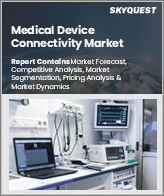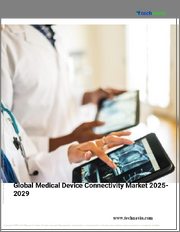
|
시장보고서
상품코드
1736967
세계의 의료기기 커넥티비티 시장 규모, 점유율, 성장 분석, 제품별, 기술별, 용도별, 최종사용자별, 지역별 - 산업 예측(2025-2032년)Medical Device Connectivity Market Size, Share, and Growth Analysis, By Product, By Technology, By Application, By End User, By Region - Industry Forecast 2025-2032 |
||||||
의료기기 커넥티비티 세계 시장 규모는 2023년 26억 달러, 2024년 31억 7,000만 달러에서 2032년에는 156억 8,000만 달러로 성장하고, 예측 기간(2025-2032년) CAGR은 22.1%를 보일 것으로 예측됩니다.
의료기기 커넥티비티 시장은 헬스케어 시스템과 기술의 상호 연결성 증가로 인해 큰 성장을 이루고 있습니다. 이 분야는 의료기기와 병원 네트워크, IT 시스템, 클라우드 플랫폼과의 통합에 중점을 두어 실시간 데이터 전송을 용이하게 하고, 기기, 환자, 의료 서비스 제공업체 간의 커뮤니케이션을 강화하는 데 중점을 두고 있습니다. 주요 촉진요인으로는 의료용 사물인터넷(IoMT) 기기의 채택 증가, 원격 환자 모니터링에 대한 수요, 헬스케어 분야에서 데이터 기반 통찰력의 필요성 등이 있습니다. 이러한 발전은 환자 치료를 개선하고, 실수를 줄이고, 의사결정을 정보화하고 있지만, 데이터 보안, 상호운용성, 규제적 장애물 등의 과제도 남아있습니다. 의료기기와 전자 의료 기록(EHR)의 통합은 임상적 의사 결정과 진료 조정을 강화하여 궁극적으로 의료 결과를 향상시킴으로써 이 시장을 더욱 강화할 것입니다.
목차
서론
- 조사 목적
- 조사 범위
- 정의
조사 방법
- 정보 조달
- 2차와 1차 데이터 방법
- 시장 규모 예측
- 시장 전제조건과 제한
주요 요약
- 세계 시장 전망
- 공급과 수요 동향 분석
- 부문별 기회 분석
시장 역학과 전망
- 시장 개요
- 시장 규모
- 시장 역학
- 성장 촉진요인과 기회
- 성장 억제요인과 과제
- Porter의 Five Forces 분석
주요 시장 인사이트
- 중요 성공 요인
- 경쟁 정도
- 주요 투자 기회
- 시장 생태계
- 시장의 매력 지수(2024년)
- PESTEL 분석
- 거시경제 지표
- 밸류체인 분석
- 가격 분석
- 기술 분석
의료기기 커넥티비티 시장 규모 : 제품별&CAGR(2025-2032)
- 시장 개요
- 의료기기 커넥티비티 솔루션
- 의료기기 통합 솔루션
- 텔레메트리 시스템
- 접속 허브
- 인터페이스 디바이스
- 주변 기술 및 의료기기
- 환자 모니터링 장비
- 집중 치료 기구
- 영상 시스템
- 기타 주변 기술 및 의료기기
- 의료기기 커넥티비티 서비스
- 지원 및 유지관리 서비스
- 구현 및 통합 서비스
- 트레이닝 서비스
- 컨설팅 서비스
의료기기 커넥티비티 시장 규모 : 기술별&CAGR(2025-2032)
- 시장 개요
- 무선 기술
- 클라우드 기반 기술
- Bluetooth 기술
- 기타 무선 기술
- 유선 기술
- LAN 기술
- WAN 기술
- 하이브리드 기술
의료기기 커넥티비티 시장 규모 : 용도별&CAGR(2025-2032)
- 시장 개요
- 바이탈 사인 및 환자 모니터
- 혈당 모니터
- ECG 및 심박수 모니터
- 혈압 모니터
- 멀티 파라미터 모니터
- 옥시미터
- 환자 모니터
- 마취기
- 인공호흡기
- 주입 펌프
- 영상 시스템
- MRI 및 CT 장비
- 초음파 시스템
- X선 장비
- 기타 영상 시스템
- 호흡기 디바이스
- 기타 용도
- 임플란트
- 페이스메이커
- 기타 용도
의료기기 커넥티비티 시장 규모 : 최종사용자별&CAGR(2025-2032)
- 시장 개요
- 병원 및 외과센터
- 가정치료 환경
- 외래 및 외래 진료 설정
- 진단 및 영상 진단센터
- 기타 최종사용자
의료기기 커넥티비티 시장 규모 : 지역별&CAGR(2025-2032)
- 북미
- 미국
- 캐나다
- 유럽
- 독일
- 스페인
- 프랑스
- 영국
- 이탈리아
- 기타 유럽
- 아시아태평양
- 중국
- 인도
- 일본
- 한국
- 기타 아시아태평양
- 라틴아메리카
- 브라질
- 기타 라틴아메리카
- 중동 및 아프리카
- GCC 국가
- 남아프리카공화국
- 기타 중동 및 아프리카
경쟁 정보
- 주요 5개사 비교
- 주요 기업의 시장 포지셔닝(2024년)
- 주요 시장 기업이 채택한 전략
- 최근 시장 동향
- 기업의 시장 점유율 분석(2024년)
- 주요 기업 개요
- 기업 상세
- 제품 포트폴리오 분석
- 기업 부문별 점유율 분석
- 매출 전년대비 비교(2022-2024년)
주요 기업 개요
- Koninklijke Philips N.V.
- Cerner Corporation
- Medtronic
- General Electric
- Stryker
- iHealth Labs Inc.
- Cisco Systems, Inc
- Masimo
- Infosys Limited
- Baxter
- TE Connectivity
- Lantronix Inc
- Hill-Rom Services Inc.
- Silex Technology America, Inc
- Digi International Inc.
결론과 제안
LSH 25.06.12Global Medical Device Connectivity Market size was valued at USD 2.6 billion in 2023 and is poised to grow from USD 3.17 billion in 2024 to USD 15.68 billion by 2032, growing at a CAGR of 22.1% during the forecast period (2025-2032).
The medical device connectivity market is witnessing substantial growth driven by the increasing interconnectivity of healthcare systems and technologies. This sector emphasizes the integration of medical devices with hospital networks, IT systems, and cloud platforms, facilitating real-time data transfer and enhancing communication between devices, patients, and providers. Key drivers include rising adoption of Internet of Medical Things (IoMT) devices, demand for remote patient monitoring, and the necessity for data-driven insights in healthcare. While advancements improve patient care, reduce errors, and inform decision-making, challenges such as data security, interoperability, and regulatory hurdles persist. The integration of medical devices with electronic health records (EHRs) further bolsters this market by enhancing clinical decision-making and care coordination, ultimately improving healthcare outcomes.
Top-down and bottom-up approaches were used to estimate and validate the size of the Global Medical Device Connectivity market and to estimate the size of various other dependent submarkets. The research methodology used to estimate the market size includes the following details: The key players in the market were identified through secondary research, and their market shares in the respective regions were determined through primary and secondary research. This entire procedure includes the study of the annual and financial reports of the top market players and extensive interviews for key insights from industry leaders such as CEOs, VPs, directors, and marketing executives. All percentage shares split, and breakdowns were determined using secondary sources and verified through Primary sources. All possible parameters that affect the markets covered in this research study have been accounted for, viewed in extensive detail, verified through primary research, and analyzed to get the final quantitative and qualitative data.
Global Medical Device Connectivity Market Segments Analysis
Global Medical Device Connectivity Market is segmented by Product, Technology, Application, End User and region. Based on Product, the market is segmented into Medical Device Connectivity Solutions, Peripheral Technologies/Medical Devices and Medical Device Connectivity Services. Based on Technology, the market is segmented into Wireless Technologies, Wired Technologies and Hybrid Technologies. Based on Application, the market is segmented into Vital Signs & Patient Monitors, Anesthesia Machines, Ventilators, Infusion Pumps, Imaging Systems, Respiratory Devices and Other Applications. Based on End User, the market is segmented into Hospitals & Surgical Centers, Home Care Settings, Ambulatory & OPD Settings, Diagnostic & Imaging Centers and Other End Users. Based on region, the market is segmented into North America, Europe, Asia Pacific, Latin America and Middle East & Africa.
Driver of the Global Medical Device Connectivity Market
The expansion of the global medical device connectivity market is primarily fueled by the extensive integration of connected medical devices in healthcare. These devices facilitate smooth communication among various healthcare systems and patient monitoring units, which enhances real-time monitoring, data collection, and information sharing between healthcare professionals and patients. As the focus on personalized healthcare and remote monitoring rises, the necessity for robust medical device connectivity is anticipated to further escalate. For instance, wearable technology that tracks vital parameters such as heart rate, glucose levels, or oxygen saturation allows physicians to observe their patients from a distance, minimizing the need for in-person hospital visits.
Restraints in the Global Medical Device Connectivity Market
The growing interconnectedness of medical devices has raised considerable concerns regarding data privacy and cybersecurity, posing significant challenges to the Global Medical Device Connectivity market. As medical devices frequently transmit sensitive patient information, they become prime targets for cybercriminal activities. Security breaches or unauthorized access to healthcare data can have dire repercussions, jeopardizing patient safety and leading to legal complications. While ensuring the secure transmission and storage of medical data is paramount, numerous healthcare systems face obstacles in establishing effective security measures. This struggle ultimately stifles market growth and underscores the need for enhanced protection protocols in the industry.
Market Trends of the Global Medical Device Connectivity Market
The Global Medical Device Connectivity market is witnessing a significant trend towards the integration of Artificial Intelligence (AI) and Machine Learning (ML) technologies. This advancement enhances the functionality of connected medical devices by enabling real-time data analysis and abnormality detection, which are crucial for timely interventions. AI-driven wearables, for instance, can proactively alert healthcare providers and patients to critical health issues, contributing to improved patient outcomes. This trend not only enhances clinical effectiveness but also streamlines healthcare delivery and reduces associated costs, positioning it as a key driver for market growth in the coming years.
Table of Contents
Introduction
- Objectives of the Study
- Scope of the Report
- Definitions
Research Methodology
- Information Procurement
- Secondary & Primary Data Methods
- Market Size Estimation
- Market Assumptions & Limitations
Executive Summary
- Global Market Outlook
- Supply & Demand Trend Analysis
- Segmental Opportunity Analysis
Market Dynamics & Outlook
- Market Overview
- Market Size
- Market Dynamics
- Drivers & Opportunities
- Restraints & Challenges
- Porters Analysis
- Competitive rivalry
- Threat of substitute
- Bargaining power of buyers
- Threat of new entrants
- Bargaining power of suppliers
Key Market Insights
- Key Success Factors
- Degree of Competition
- Top Investment Pockets
- Market Ecosystem
- Market Attractiveness Index, 2024
- PESTEL Analysis
- Macro-Economic Indicators
- Value Chain Analysis
- Pricing Analysis
- Technology Analysis
Global Medical Device Connectivity Market Size by Product & Service & CAGR (2025-2032)
- Market Overview
- Medical Device Connectivity Solutions
- Medical Device Integration Solutions
- Telemetry Systems
- Connectivity Hubs
- Interface Devices
- Peripheral Technologies/Medical Devices
- Patient Monitoring Devices
- Critical Care Instruments
- Imaging Systems
- Other Peripheral Technologies/Medical Devices
- Medical Device Connectivity Services
- Support & Maintenance Services
- Implementation & Integration Services
- Training Services
- Consulting Services
Global Medical Device Connectivity Market Size by Technology & CAGR (2025-2032)
- Market Overview
- Wireless Technologies
- Cloud-Based Technologies
- Bluetooth Technologies
- Other Wireless Technologies
- Wired Technologies
- Lan Technologies
- Wan Technologies
- Hybrid Technologies
Global Medical Device Connectivity Market Size by Application & CAGR (2025-2032)
- Market Overview
- Vital Signs & Patient Monitors
- Blood Glucose Monitors
- ECG/Heart Rate Monitors
- Blood Pressure Monitors
- Multiparameter Monitors
- Oximeters
- Patient Monitors
- Anesthesia Machines
- Ventilators
- Infusion Pumps
- Imaging Systems
- MRI & CT Machines
- Ultrasound Systems
- X-Ray Machines
- Other Imaging Systems
- Respiratory Devices
- Other Applications
- Implants
- Pacemakers
- Other Medical Device Connectivity Solutions
Global Medical Device Connectivity Market Size by End User & CAGR (2025-2032)
- Market Overview
- Hospitals & Surgical Centers
- Home Care Settings
- Ambulatory & OPD Settings
- Diagnostic & Imaging Centers
- Other End Users
Global Medical Device Connectivity Market Size & CAGR (2025-2032)
- North America (Product & Service, Technology, Application, End User)
- US
- Canada
- Europe (Product & Service, Technology, Application, End User)
- Germany
- Spain
- France
- UK
- Italy
- Rest of Europe
- Asia Pacific (Product & Service, Technology, Application, End User)
- China
- India
- Japan
- South Korea
- Rest of Asia-Pacific
- Latin America (Product & Service, Technology, Application, End User)
- Brazil
- Rest of Latin America
- Middle East & Africa (Product & Service, Technology, Application, End User)
- GCC Countries
- South Africa
- Rest of Middle East & Africa
Competitive Intelligence
- Top 5 Player Comparison
- Market Positioning of Key Players, 2024
- Strategies Adopted by Key Market Players
- Recent Developments in the Market
- Company Market Share Analysis, 2024
- Company Profiles of All Key Players
- Company Details
- Product Portfolio Analysis
- Company's Segmental Share Analysis
- Revenue Y-O-Y Comparison (2022-2024)
Key Company Profiles
- Koninklijke Philips N.V.
- Company Overview
- Business Segment Overview
- Financial Updates
- Key Developments
- Cerner Corporation
- Company Overview
- Business Segment Overview
- Financial Updates
- Key Developments
- Medtronic
- Company Overview
- Business Segment Overview
- Financial Updates
- Key Developments
- General Electric
- Company Overview
- Business Segment Overview
- Financial Updates
- Key Developments
- Stryker
- Company Overview
- Business Segment Overview
- Financial Updates
- Key Developments
- iHealth Labs Inc.
- Company Overview
- Business Segment Overview
- Financial Updates
- Key Developments
- Cisco Systems, Inc
- Company Overview
- Business Segment Overview
- Financial Updates
- Key Developments
- Masimo
- Company Overview
- Business Segment Overview
- Financial Updates
- Key Developments
- Infosys Limited
- Company Overview
- Business Segment Overview
- Financial Updates
- Key Developments
- Baxter
- Company Overview
- Business Segment Overview
- Financial Updates
- Key Developments
- TE Connectivity
- Company Overview
- Business Segment Overview
- Financial Updates
- Key Developments
- Lantronix Inc
- Company Overview
- Business Segment Overview
- Financial Updates
- Key Developments
- Hill-Rom Services Inc.
- Company Overview
- Business Segment Overview
- Financial Updates
- Key Developments
- Silex Technology America, Inc
- Company Overview
- Business Segment Overview
- Financial Updates
- Key Developments
- Digi International Inc.
- Company Overview
- Business Segment Overview
- Financial Updates
- Key Developments
















